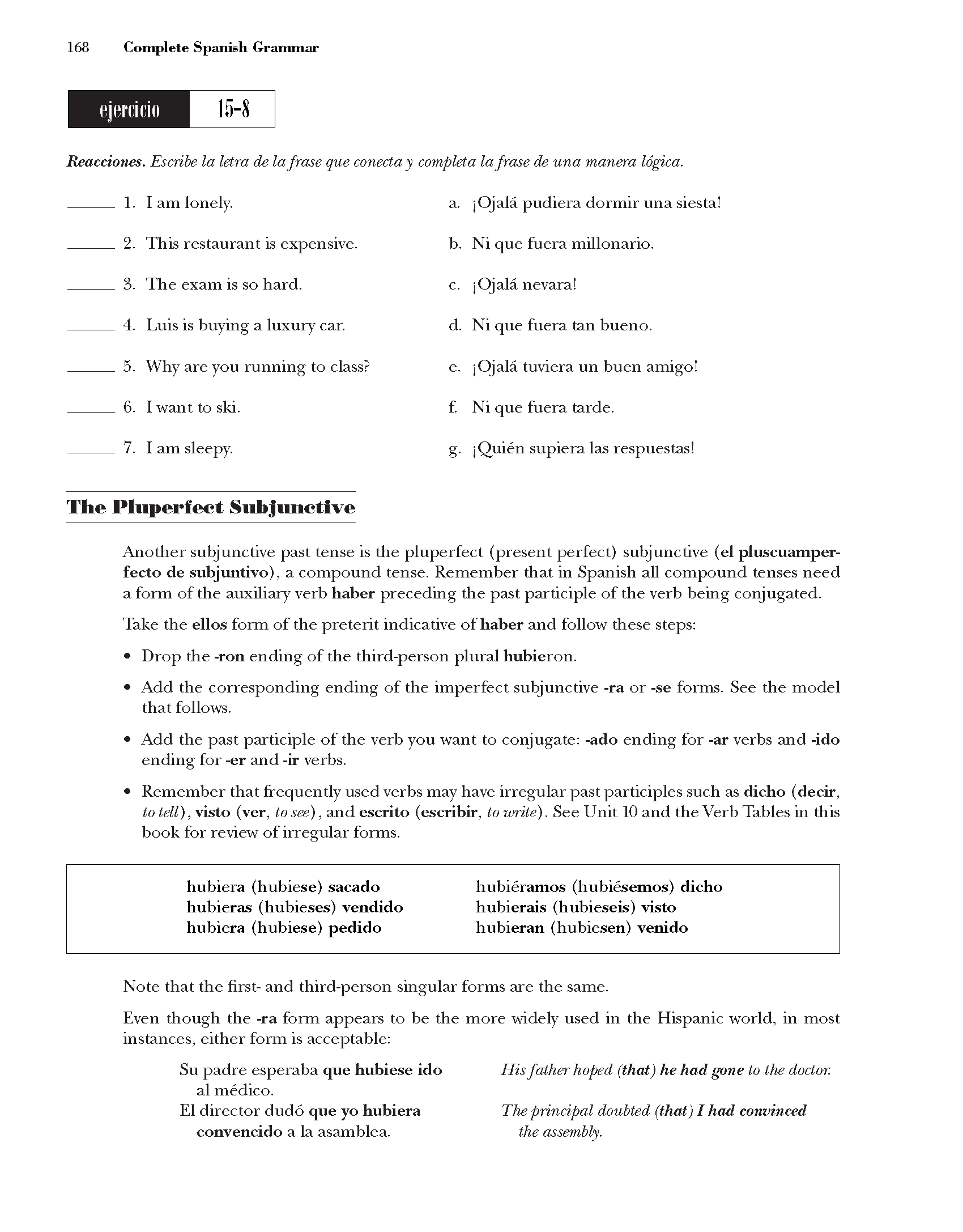CSG179

168 Complete Spanish Grammar
15-8
ejercicio
Reacciones. Escńbe la letra de la frase que conecta y completa la frase de una manera lógica.
|
1. |
I am lonely. |
a. |
jOjala pudiera dormir una siesta! |
|
2. |
This restaurant is expensive. |
b. |
Ni que fuera millonario. |
|
3. |
The exam is so hard. |
c. |
jOjala nevara! |
|
4. |
Luis is buying a luxury car. |
d. |
Ni que fuera tan bueno. |
|
5. |
Why are you running to class? |
e. |
jOjala Uwiera un buen amigo! |
|
6. |
I want to ski. |
f. |
Ni que fuera tarde. |
|
1. |
I am sleepy. |
8'- |
jQuien supiera las respuestas! |
The Pluperfeet Subjimctive
Another subjunctive past tense is the pluperfeet (present perfect) subjunctive (el pluscuamper-
fecto de subjuntivo), a compound tense. Remember that in Spanish all compound tenses need
a form of the auxiliary verb haber preceding the past participle of the verb being conjugated.
Take the ellos form of the preterit indicative of haber and follow these steps:
• Drop the -ron ending of the third-person plural hubieron.
• Add the corresponding ending of the imperfect subjunctive -ra or -se forms. See the model that follows.
• Add the past participle of the verb you want to conjugate: -ado ending for -ar verbs and -ido ending for -er and -ir verbs.
• Remember that ffequently used verbs may have irregular past participles such as dicho (decir, to tell), visto (ver, to see), and escrito (escribir, to unitę). See Unit 10 and the Verb Tables in this book for review of irregular forms.
|
hubiera (hubiese) sacado |
hubieramos (hubiesemos) dicho |
|
hubieras (hubieses) vendido |
hubierais (hubieseis) visto |
|
hubiera (hubiese) pedido |
hubieran (hubiesen) venido |
Notę that the first- and third-person singular forms are the same.
Even though the -ra form appears to be the morę widely used in the Hispanic world, in most instances, either form is acceptable:
Su padre esperaba que hubiese ido His father hoped (that) he had gone to the doctor.
al medico.
El director dudó que yo hubiera Theprincipal doubted (that)I had conuinced
convencido a la asamblea. the assembly.
Wyszukiwarka
Podobne podstrony:
CSG241 230 Complete Spanish Grammar 19-5 ejercicio Practica. Escńbe la forma apropiada del pronombre
CSG131 120 Complete Spanish Grammar 11-8ejercicio En la playa. Prdctica. Usa la forma apropiada del
CSG181 170 Complete Spanish Grammar 15-11ejercicio Una campańa pubUcitaria. Termina la frase en espa
CSG131 120 Complete Spanish Grammar 11-8ejercicio En la playa. Prdctica. Usa la forma apropiada del
CSG131 120 Complete Spanish Grammar 11-8ejercicio En la playa. Prdctica. Usa la forma apropiada del
CSG181 170 Complete Spanish Grammar 15-11ejercicio Una campańa pubUcitaria. Termina la frase en espa
CSG145 134 Complete Spanish Grammar 13-1ejercicio Prdctica. Usa la forma apropiada del presente de s
CSG155 144 Complete Spanish Grammar Impersonal expressions followed by the indicative include: es ci
CSG169 158 Complete Spanish Grammar 6. Mi amigo busca un apartamento cerca de un campo de golf. Noso
CSG307 296 Complete Spanish Grammar ejercicio Lo opuesto. Escńbe las frases en forma negativa. In so
CSG175 164 Complete Spanish Grammar ejercicio 15-1 La conjugación. Obserua las formas del preteńto d
więcej podobnych podstron